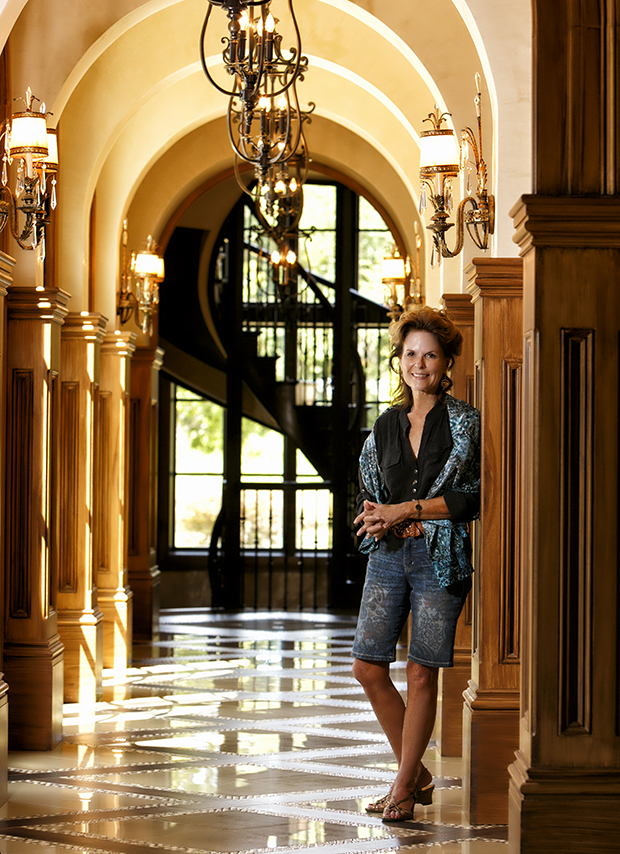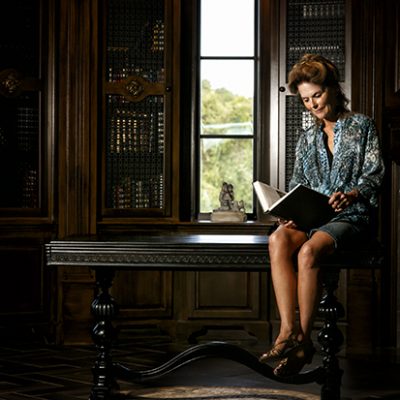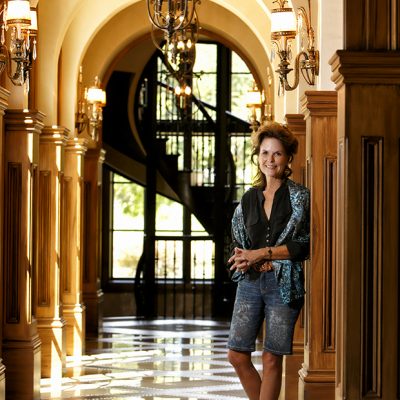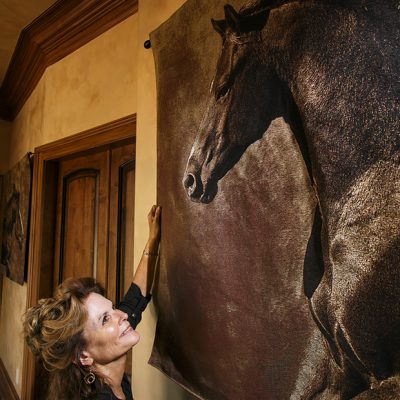
THIS RENAISSANCE WOMAN CONQUERED THE MALE-DOMINATED ARCHITECTURAL WORLD, PIONEERED HISTORIC HOME RESTORATION, RESURRECTED SEA BRIGHT’S BELOVED PENINSULA HOUSE, HEADS AN OPERA COMPANY, AND WAS ONCE OUTBID FOR MAR-A-LAGO BY DONALD TRUMP
by Laura D.C. Kolnoski • Photos By Amessé Photography
Before there was HGTV, when contractors became stars through non-tantrum-based, arduous vintage home restorations, there was Mary Weir; a petite yet formidable woman who can wield power tools as easily as she sets pen to paper as an author and playwright.
Categorizing Weir is a challenge, as she has excelled on a myriad of fronts throughout a long and illustrious career. The Pittsburgh native earned her degree and masters in architectural design from Pennsylvania State University, where she met her first husband. When he took a job in Menlo Park in 1967, they rented an apartment in Sea Bright. Weir sought a home there, but found most were too expensive, so she settled on a run-down fisherman’s row house for $4,500, which became a fledgling home restoration project.
“I had the feeling that anything near the water would increase in revenue,” she recalled.
At that time, the area was popular for rentals by seasonal fishermen and those involved at nearby Monmouth Racetrack. From that launch, she advanced to restoring homes in Long Branch, Monmouth Beach, and beyond, traveling as far as Rhode Island and Florida to regenerate estates and mansions. To date, she has restored 55 homes.
Weir saw a window of opportunity in concentrating on reviving older homes, finding a niche in taking on architectural re-construction projects others weren’t interested in. When she began, the trend was “tear down and build new,” rather than focus on costly and time-consuming restorations that involved significantly more work. Renowned for construction skills, Weir explained that she learned 99 percent of what she needed to know on the job.
“You don’t have to be a big guy; it’s more about being organized,” she said. “It’s important to get good people who care to work for you. Some were with me for ten years. I train others to go out into the world and make a difference. I feel very good about that and am proud I was in it at the beginning.” Most homes she restores are 70 to 100 years old.
“I can feel the family that built it; to bring that back is important to me,” she said. “I retain the best of the old, then bring in the best of the new.” She has restored homes with up to 40 rooms and 30,000 square feet—and is often challenged in making decisions about how people live today (rather than the early 1900s), which means keeping beautiful molding and chimneys while installing new bathrooms, working windows, and 21st-century amenities.
Weir was drawn to Newport for its “fabulous history,” and the opportunity to restore a commodore’s Stanford Whitedesigned house, whereas in Palm Beach, Florida in the mid- 1980s, many 1920s homes were clamoring for her expertise. In 1985 she decided to place a bid on the 1927 Mar-a-Lago historic landmark mansion of Marjorie Merriweather Post.
“It was for sale for a long time because it was so gargantuan,” she said. “I didn’t know what I was going to do with it, but I knew the value was there.” So did Donald Trump, who outbid her for the property. Undeterred, Weir continued her increasingly acclaimed restorations.
“I did fabulously well, eventually making more money than my first husband, who ended up working with me,” she said. During that time, she hired and trained her own construction crews and authored two books on her work: How We Made a Million Dollars Recycling Great Old Houses (McGraw-Hill Contemporary, 1980) and House Recycling: The Best Real Estate Opportunity for the ’80s. (NTC/Contemporary Publishing, 1983). By the time the couple divorced in 1979, Weir had already completed restoration on 40 homes, selling every one of them. Those transactions enabled her to make her most renowned purchase and astounding restoration of all—the beloved and historically significant Peninsula House in Sea Bright, known as the “P House.”
After one year of preliminary work, she opened the massive facility on the ocean and continued rejuvenating it for the next two years. In the process, she became a restaurateur, rising at 5:00 a.m. and hitting the kitchen by 6:00 a.m., learning to cook on the job. Working with a partner and general manager, she opened the P House’s popular Sand Bar, and created a total of five thriving restaurants and bars in the large landmark. She filled the building with architectural embellishments and vintage pieces she found during European buying trips.
“People would come to see the progress; 5,000 people would be there in a summer evening,” she recalled. “Everything I did there touched so many people, especially at the holidays and on special occasions when I would decorate. It was unlike the houses I work on where fewer people see the results. Having so many enjoy the Peninsula House was much more rewarding.” She sold it in 1983. It burned to the ground in 1986. “It was like one of my children was gone,” she admitted. “All the houses I do are like children. I still get asked about it all the time. Everyone lost history and special Jersey Shore memories in that fire.”
In 1988, friend Francis Lear, wife of late television legend Norman Lear, started the upscale Lear’s Magazine in New York City and asked Weir to get involved. “I took off my construction boots and became part of it,” she said, was chosen for the cover of the first issue, and is now forever known as “The Lear Lady.” Ahead of its time, the magazine, which folded in 1994, focused on women of means over 40.
When the magazine closed, she left her New York apartment and returned to the Jersey Shore. Monmouth University asked her to get involved with their annual Scholarship Ball. She became interested in the University’s iconic Woodrow Wilson Hall, formerly known as the Shadow Lawn mansion, and dove into researching both the structures and the families who once owned them. Her discoveries inspired her to write two plays: An Evening with the Guggenheims and Dinner at Shadow Lawn – Life in the Gilded Age, the latter presented at a private dinner party, complete with Weir in period costume acting as narrator, as well as portraying one of the homes’ occupants. She went on to head the university’s Scholarship and Holiday Balls for 20 years.
Simultaneously, Weir actively enjoyed her lifelong passion, opera, which introduced her to second husband Barry Henry. (Weir, who took singing lessons, staged her own shows in large mansions during the 1970s, inviting, “300 of my closest friends for aria performances and dinner parties.”)
In 1987, Weir enrolled her sons in an acting class run by Barry, an opera singer, actor, international successful businessman, and Australian native, who owned a synthetic diamond company in New Jersey. Weir was also working in Australia during that time in connection with a visual art exchange program through the Boston Museum of Fine Arts. Barry founded Pacific Encore Performances (PEP) in Sydney in 1993, providing emerging professionals intensive training and a bridge to the world’s greatest stages. Realizing there was no equal to PEP in New York, she started it there in 1999. The couple married in 2006. When Barry passed away in 2010, she took over the entire operation and is now its president. The multi-cultural international musical repertory company is often referred to as “The United
Nations of Song.” Over 1,000 performers have been company members over the years, performing in PEP’s annual sold-out Carnegie Hall concerts each June.
“Barry loved this company so much. I’m trying to continue the legacy, and it’s not easy,” Weir said. The biggest challenge is finding the funding, raised primarily through sponsors and special events. Major donors include the Saker family of Shop Rite fame, philanthropist sisters Carol Stillwell and Mary Larkin, and Warren Diamond, along with a core group of friends including Abbey Feiler-Kober and Thomas Kober, who host benefits for the company at their Abbey Farm mansion in Colts Neck.
Weir has also been a member of the Children’s Cultural Center Board of Trustees since 2000, and served as President of the Monmouth University Library Association from 2003 to 2007. She has been active with Save the Jersey Shore since 2012, and was Chairperson of the American Heart Ball in 2013. She is currently restoring a 1907 home in Maplewood and plans to return to Australia in November, adding that her favorite restoration is always the one she is working on at the moment.
“I love them all,” Weir added, smiling.






